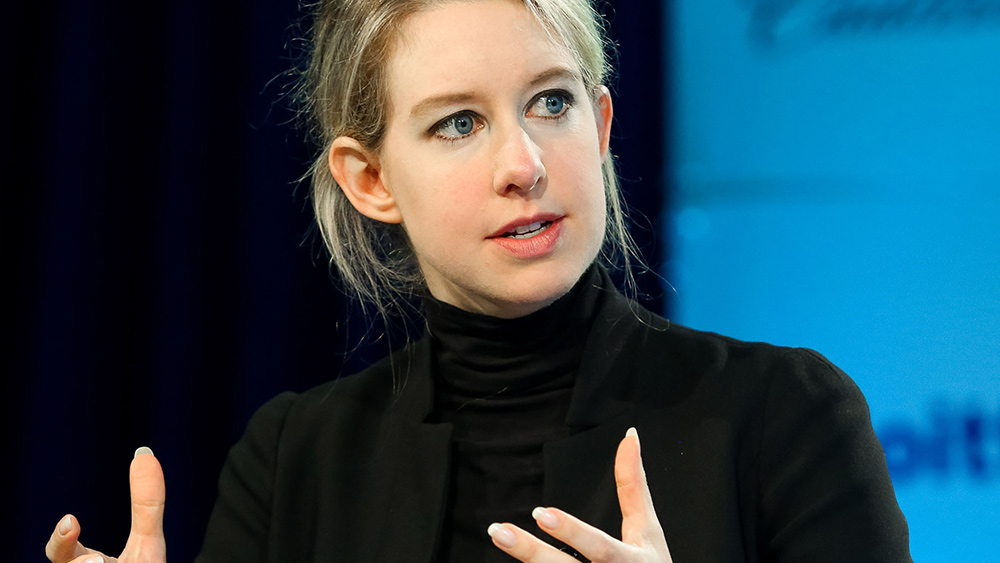How did one woman wielding FAKE SCIENCE manage to fool so many supposedly “smart” leaders in the business community?
03/25/2019 / By Vicki Batts

Theranos and its female founder, Elizabeth Holmes were widely promoted as the would-be future of feminism and medical technology. But as it turned out, her promises of life-changing technology in the world of blood testing were empty, and the science she based her entire company on was fraudulent. How did one woman fool so many people, for such a long period of time? The answer is simple: Holmes was giving the media what they wanted (a female icon) and over-eager investors simply don’t know enough about science to ask the right questions.
The age-old adage, “If it’s too good to be true, it probably is” certainly comes to mind when it comes to Theranos.
The downfall of Theranos
Holmes dropped out of Stanford University at age 19 to create her sham of a company. With an “irresistible pitch,” she claimed that early detection of over 200 illnesses could be possible with a new machine that required a minimal amount of blood. Holmes named this machine “Edison.” Investors were throwing money at her and her new company, Theranos — and Holmes quickly became the world’s youngest female billionaire.
Business Insider reports that Holmes freely took investors’ money under the condition that she would never reveal to them how her “technology” worked. Why this wasn’t a red flag for the people who invested millions of dollars in Theranos remains a bit of mystery. Sources say that secrecy was the status quo for Holmes and Theranos.
Overall, many new technologies are over-stated and over-hyped; when Theranos started picking up more media attention, many outsiders suspected that the promise of testing for everything with just a finger stick may have been a bit of exaggeration. Ian Gibbons, Theranos’ Chief Scientist and one of the first people hired, warned Holmes that their blood testing technology wasn’t where it needed to be. Gibbons told her that Edison wasn’t ready for public use and that inaccuracies in the testing were a problem that needed to be corrected.
Vice President Joe Biden visited Theranos in 2015 — and left the lab singing their praises. But as it turns out, the “lab” he visited was a fraud. The devices he saw didn’t actually work and the entire setup had been staged for his visit.
In August 2015, the FDA was already looking into Theranos; regulators said they found “major inaccuracies” within the product. In October 2015, Wall Street Journal reporter John Carreyrou was investigating Theranos, as well. His reporting ultimately led to the company’s downfall.
Carreyrou revealed that Edison didn’t work — and that Theranos had been using the same standard old blood testing machines used by their conventional competitors. Shortly thereafter, Holmes was banned from the lab-testing industry. Ultimately, Theranos wellness centers closed their doors and lab operations were put to bed.
In early 2018, Holmes was charged with “massive fraud” by the SEC. Sources report that Holmes gave up her voting and financial control in Theranos. She also agreed to pay a $500,000 fine and return 18.9 million shares of company stock.
Holmes was also barred from holding director or officer positions within a publicly traded company for the next 10 years.
Fraudulent science runs amok
Holmes was lauded as the second coming of Steve Jobs by the left-leaning media, hungry for at least the illusion of “female empowerment” — even if there was no sustenance to sustain the image. Before the company imploded, Theranos and its CEO received nothing but positive press. Theranos was presented as a life-saving breakthrough technology — even though no one outside the company had even the slightest idea as to how it worked. Holmes’ extreme level of secrecy about how Edison worked should have been a major red flag — especially to investors.
And yet, the company had no shortage of lenders– some of whom lost $100 million or more on the Theranos scam. Who would invest in a company when the leader can’t even tell you how their product works? It would seem like common sense, but the “woo” of proprietary technology gave Holmes carte blanche with venture capitalists. And for people with no background in science, medicine or tech, “woo” can be a pretty powerful thing.
Combined with the overwhelmingly good press, it’s not hard to figure out why and how Theranos fooled so many people: Holmes was given a “pass” from the media. No one questioned how Edison worked — or questioned why she refused to explain how it worked, for that matter.
This is starting to sound awful familiar, isn’t it? We see the same kind of attitude from the medical community and the media towards most of the pharmaceutical industry’s products, as well as GMOs, cellphones and other forms of technology. Can these industries actually predict with certainty what the long-term effects of exposure to cellphone radiation will be, or what effects GMOs will have on our food supply over the long haul? Fake science is everywhere, if you’re willing to look for it.
And yet, so many people are buying into the promise that these things will make our lives “better,” even without evidence. Learn more at FakeScience.news.
Sources for this article include:
Tagged Under: bad tech, corruption, deception, dishonest, Elizabeth Holmes, false-flag, fraud, left cult, mainstream media, scams, science clowns, science fraud, SEC, stupid, Theranos



















